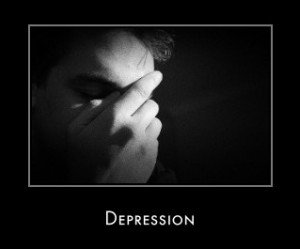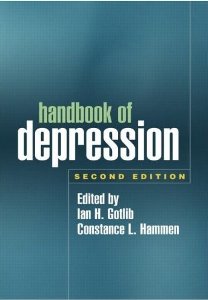|
DepressionThinking About Becoming A Psychology Student? Find A Psychology School Near YouDepression
(photo Credit: Lloyd Morgan) The following information is provided courtesy of The National Institute of mental Health. What is Depression?Everyone occasionally feels blue or sad, but these feelings are usually fleeting and pass within a couple of days. When a person has a depressive disorder, it interferes with daily life, normal functioning, and causes pain for both the person with the disorder and those who care about him or her. Depression is a common but serious illness, and most who experience it need treatment to get better. Many people with a depressive illness never seek treatment. But the vast majority, even those with the most severe depression, can get better with treatment. Intensive research into the illness has resulted in the development of medications, psychotherapies, and other methods to treat people with this disabling disorder. Types-of-DepressionThere are several forms of depressive disorders. The most common are major depressive disorder and dysthymic disorder. Major depressive disorder, also called major-depression, is characterized by a combination of symptoms that interfere with a person's ability to work, sleep, study, eat, and enjoy once–pleasurable activities. Major-depression is disabling and prevents a person from functioning normally. An episode of major-depression may occur only once in a person's lifetime, but more often, it recurs throughout a person's life. Dysthymic disorder, also called dysthymia, is characterized by long–term (two years or longer) but less severe symptoms that may not disable a person but can prevent one from functioning normally or feeling well. People with dysthymia may also experience one or more episodes of major-depression during their lifetimes. Some forms of depressive disorder exhibit slightly different characteristics than those described above, or they may develop under unique circumstances. However, not all scientists agree on how to characterize and define these forms of depression. They include: Psychotic-depression, which occurs when a severe depressive illness is accompanied by some form of psychosis, such as a break with reality, hallucinations, and delusions. Postpartum-depression, which is diagnosed if a new mother develops a major depressive episode within one month after delivery. It is estimated that 10 to 15 percent of women experience postpartum-depression after giving birth. Seasonal affective disorder (SAD), which is characterized by the onset of a depressive illness during the winter months, when there is less natural sunlight. The depression generally lifts during spring and summer. SAD may be effectively treated with light therapy, but nearly half of those with SAD do not respond to light therapy alone. Antidepressant medication and psychotherapy can reduce SAD symptoms, either alone or in combination with light therapy. Bipolar disorder, also called manic-depressive illness, is not as common as major-depression or dysthymia. Bipolar disorder is characterized by cycling mood changes-from extreme highs (e.g., mania) to extreme lows (e.g., depression). Symptoms-of-DepressionPeople with depressive illnesses do not all experience the same symptoms. The severity, frequency and duration of symptoms will vary depending on the individual and his or her particular illness. Symptoms include: Co–existing Illness Depression often co–exists with other illnesses. Such illnesses may precede the disorder, cause it, and/or be a consequence of it. It is likely that the mechanics behind the intersection of depression and other illnesses differ for every person and situation. Regardless, these other co–occurring illnesses need to be diagnosed and treated. Anxiety disorders, such as post–traumatic stress disorder (PTSD), obsessive–compulsive disorder, panic disorder, social phobia and generalized anxiety disorder, often accompany depression. People experiencing PTSD are especially prone to having co-occurring-depression. PTSD is a debilitating condition that can result after a person experiences a terrifying event or ordeal, such as a violent assault, a natural disaster, an accident, terrorism or military combat. People with PTSD often re–live the traumatic event in flashbacks, memories or nightmares. Other symptoms include irritability, anger outbursts, intense guilt, and avoidance of thinking or talking about the traumatic ordeal. In a National Institute of Mental Health (NIMH)–funded study, researchers found that more than 40 percent of people with PTSD also had depression at one-month and four-month intervals after the traumatic event. Alcohol and other substance abuse or dependence may also co–occur with depression. In fact, research has indicated that the co–existence of mood disorders and substance abuse is pervasive among the U.S. population. Depression also often co–exists with other serious medical illnesses such as heart disease, stroke, cancer, hiv/aids, diabetes, and Parkinson's disease. Studies have shown that people who have the disorder in addition to another serious medical illness tend to have more severe symptoms of both depression and the medical illness, more difficulty adapting to their medical condition, and more medical costs than those who do not have co–existing depression. Research has yielded increasing evidence that treating the depression can also help improve the outcome of treating the co–occurring illness. What-Causes-Depression?There is no single known cause of depression. Rather, it likely results from a combination of genetic, biochemical, environmental, and psychological factors. Research indicates that depressive illnesses are disorders of the brain. Brain-imaging technologies, such as magnetic resonance imaging (MRI), have shown that the brains of people who have depression look different than those of people without depression. The parts of the brain responsible for regulating mood, thinking, sleep, appetite and behavior appear to function abnormally. In addition, important neurotransmitters–chemicals that brain cells use to communicate–appear to be out of balance. But these images do not reveal why the depression has occurred. Some types of depression tend to run in families, suggesting a genetic link. However, depression can occur in people without family histories of the condition as well. Genetics research indicates that risk for depression results from the influence of multiple genes acting together with environmental or other factors. In addition, trauma, loss of a loved one, a difficult relationship, or any stressful situation may trigger a depressive episode. Subsequent depressive episodes may occur with or without an obvious trigger. Depression-in Men-&-WomenMen Men often experience depression differently than women and may have different ways of coping with the symptoms. Men are more likely to acknowledge having fatigue, irritability, loss of interest in once–pleasurable activities, and sleep disturbances, whereas women are more likely to admit to feelings of sadness, worthlessness and/or excessive guilt. Men are more likely than women to turn to alcohol or drugs when they are depressed, or become frustrated, discouraged, irritable, angry and sometimes abusive. Some men throw themselves into their work to avoid talking about their depression with family or friends, or engage in reckless, risky behavior. And even though more women attempt suicide, many more men die by suicide in the United States. Women Depression is more common among women than among men. Biological, life cycle, hormonal and psychosocial factors unique to women may be linked to women's higher depression-rate. Researchers have shown that hormones directly affect brain chemistry that controls emotions and mood. For example, women are particularly vulnerable to depression after giving birth, when hormonal and physical changes, along with the new responsibility of caring for a newborn, can be overwhelming. Many new mothers experience a brief episode of the "baby blues," but some will develop postpartum-depression, a much more serious condition that requires active treatment and emotional support for the new mother. Some studies suggest that women who experience postpartum-depression often have had prior depressive episodes. Some women may also be susceptible to a severe form of premenstrual syndrome (PMS), sometimes called premenstrual dysphoric disorder (PMDD), a condition resulting from the hormonal changes that typically occur around ovulation and before menstruation begins. During the transition into menopause, some women experience an increased risk for depression. Scientists are exploring how the cyclical rise and fall of estrogen and other hormones may affect the brain chemistry that is associated with depressive illness. Finally, many women face the additional stresses of work and home responsibilities, caring for children and aging parents, abuse, poverty, and relationship strains. It remains unclear why some women faced with enormous challenges develop depression, while others with similar challenges do not. Depression-in-Children-&-AdolescentsScientists and doctors have begun to take seriously the risk of depression-in-children. Research has shown that childhood depression often persists, recurs and continues into adulthood, especially if it goes untreated. The presence of childhood-depression also tends to be a predictor of more severe illnesses in adulthood. A child with depression may pretend to be sick, refuse to go to school, cling to a parent, or worry that a parent may die. Older children may sulk, get into trouble at school, be negative and irritable, and feel misunderstood. Because these signs may be viewed as normal mood swings typical of children as they move through developmental stages, it may be difficult to accurately diagnose a young person with depression. Before puberty, boys and girls are equally likely to develop depressive disorders. By age 15, however, girls are twice as likely as boys to have experienced a major depressive episode. Depression-in-adolescence comes at a time of great personal change–when boys and girls are forming an identity distinct from their parents, grappling with gender issues and emerging sexuality, and making decisions for the first time in their lives. Depression-in-adolescence frequently co–occurs with other disorders such as anxiety, disruptive behavior, eating disorders or substance abuse. It can also lead to increased risk for suicide. More Depression InformationClick Here for information on depression-treatment and help. Essential ReadingHandbook of Depression, Second Edition by Ian H. Gotlib & Constance L. Hammen
Book Description Bringing together the field's leading authorities, this acclaimed work is widely regarded as the standard reference on depression. The Handbook provides comprehensive coverage of the epidemiology, course, and outcome of depressive disorders; issues in assessment and diagnosis; psychological and biological risk factors; effective approaches to prevention and treatment; and the nature-of-depression in specific populations. Each chapter offers a definitive statement of current theories, methods, and research findings, while also identifying key questions that remain unanswered. Reflecting significant developments in the field, the second edition is thoroughly updated and includes a number of new chapters and topics. See following link for more details: Handbook of Depression, Second Edition Classic Articles All Psychology Students Should Read
This special Kindle collection consists of the most influential, infamous and iconic research articles ever published in the history of psychology. See following link for full details. The Psychology Classics Kindle Collection Go Back To The Main Mental Health Page Go From Depression Back To The Home Page
|







